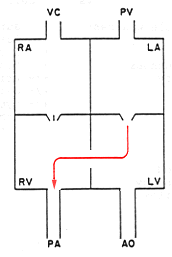Lesson 6,
Topic 1
In Progress
Overview
Lesson Progress
0% Complete

Abnormality: A defect allowing blood flow between the left and right ventricle. The defect on the right side is usually beneath the septal leaflet of the tricuspid valve. The defect on the left side is usually beneath the aortic valve.
The hemodynamic consequences of VSD consist of:
- eccentric hypertrophy of the left ventricle, and right ventricle. The right ventricle is more distensible than the left ventricle thus reduced left ventricular distensibility becomes the main problem leading to congestive heart failure. It appears that flow across the defect usually streams directly into the pulmonary artery without significant mixing and distention of the right ventricle
- a marked % of LV cardiac output is detoured from its true target
- if the volume of shunt flow is very high, the pulmonary vasculature may respond with profound pulmonary artery hyperplasia resulting in severe pulmonary artery hypertension. This will result in a reversal of blood shunt flow from right to left. This causes systemic hypoxemia. We have never documented such a scenario.
